| MiG Alley: Another Look
by Leonard "Viking1" Hjalmarson |
||||
|
Why does the AI choose to fly to a low priority, low use Choke point deep in North Korea instead of critical targets much closer to the action? If you go to Directives and click on Choke, a dialog of Selection Results will be displayed. This shows the targets in order of priority for targeting. The higher the flow of supplies through a choke point the higher the target is in the list. The Directives AI then determines how many aircraft should be allocated to the target. If the target is close to active MiG airfields then an escort will be needed. The size of the escort depends on the size of the MiG threat. In a similar way AAA activity will be used to determine AAA escort.
 MiG Alley Directives The Selection Results dialog shows that there are sufficient aircraft to hit the first two targets but not enough to hit the third. In fact we have to go down the list a few more places before we find a target that is “weak” enough to be targeted by the remaining aircraft at your disposal.
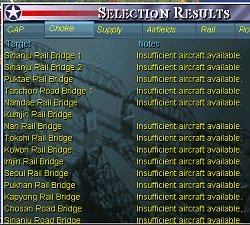
Going for Choke targets first is a long-term strategy, which seems reasonable for the start of the Spring Offensive. Also, the higher that you can cut the supplies, the smaller the number of cross-country options that can be used to bypass the cut bridge. As the war progresses you can change priorities by dragging and dropping the target types and/or changing the aircraft allocated. So the default set could be tweaked by reducing the aircraft allocated until only the first two missions are covered. The aircraft released could then be used for something else, for instance armed reconn just behind the front lines. This shows how flexible the directives are. Essentially you can tune up the directives and get the missions you want rather than manually building missions. Don’t forget that you can change the priority of mission types by dragging and dropping the types to re-order the list.
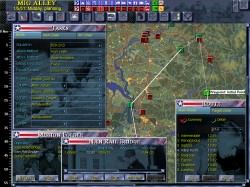 MiG Alley Tasking We would expect though that real enthusiasts would find that manually building the missions is more rewarding. However we do have to cater for a wide range of users. In any case you can use the Directives to set the framework of a session’s strikes and then tinker with them. My point is that a human being can always do better but the Directives are a good starting point and people have won the campaign using them when they have learnt how to change priorities. The real challenge is to find a strategy, which means that you win in the shortest possible time. You have from January to the third week of June. That is just short of 600 sessions! But it is likely that you will have to duck some session because you are running low of aircraft. To do this go to the Frag with no missions set. BARCAP, Flight Modeling You flew the C5 default and encountered no MiGs Did you have a BarCap up? This is definitely the most exciting place to be. That is why we put players by default into the Sabre. Sometimes the MiGs get through to the bombers sometimes they don’t. You questioned the MiG flight and physics modelling. The MiG model used depends on the Preferences. If you have complex pilots set then all AI aircraft go through the same flight model as the manual pilot. The AI “moves” the stick. If the simple model is set then only aircraft engaged with the pilot use the complex model. The rest use the same energy model but a simpler manoeuvring model. To say any more we would have to know what settings you had and what exactly you saw. Call for a vector to the strike group. This is an omission that we could think about addressing. I use ALT F2 to lock to the leader of the strike group. (Ed.Note: The "escortee" view was not available in earlier versions, a great addition!) Ground attack ability. If the ai hit the target everytime I think we would get some complaints! There is a reasonable hit rate and you know the old saying: if you want a job done well, do it yourself! You make a good point about waypoint vectoring. Adding the vector to the dialog would be useful. However, you can get the info when in the cockpit. Ctrl f4 to reset back to current waypoint. Engagement AI Leaving the area when out of stores. For the fighter-bombers there is logic to change stores to keep pounding at a target until the aircraft is really out of stores. However the B29s go home as soon as they have dropped their bombs. Once in the air, you have no control over the big bombers. We don’t know why they turned back. However it is worth mentioning that they have their own waypoints in the target area (distinct from your own) and they may have been following them. B29 missions work fine for us but you may have found an odd situation. We would like to know more. Post Combat/Send All Home. There is some confusion here. We should have said Post Air Combat. For instance, “Send All Home” issues an instruction for all aircraft in your group to disengage and reform with the group leader. Note that fighter-bombers in non-air combat roles can get embroiled in air combat if their escort is ineffective. Then these commands could be used. AI aircraft dis-engage sensibly. By that I mean that they don’t just turn for home, they need to be sure that it is safe to do so. If they are not dis-engaging, ask for a Status report and find out who needs help. |
For non-air combat missions, when you are in a strike group then you can use the FAC menu to issue some general commands:
Begin your run
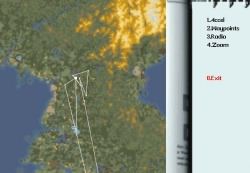 MAP and ACCEL Interface If you are not in the strike group you cannot influence them, they are in charge. To control your group you have to use the map screen to change waypoints. Highlight the waypoint you want and then make the Next WP = highlighted WP choice. NAV and Group Control, Cockpit Dials Why is the current waypoint still the target? If you are not in accel you have to fly near/through a waypoint for the system to automatically move you onto the next waypoint. Alternatively you can use the map screen to change the next waypoint.
 You asked for more info on the Fuel Dials. The Sabre cockpit in the sim is taken from photographs of the instrument panel of an F86A-1. A comparison between these instruments and those found in an F86F show a number of minor differences including a change in the fuel gauge. The A model has an internal fuel gauge which reads in US gallons and can also have a fuel totaliser (in some versions this instrument is replaced by a course indicator). The F86F-1 through to F86F-30 aircraft typically had one fuel gauge which displayed the internal fuel in units of 100lbs.
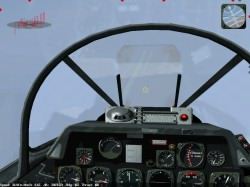 Although three versions of the F86 are modeled in the sim, the variations in the cockpit layout have not been included. All the versions use the F86A panel except that we have replaced the fuel totaliser with a simple total fuel gauge calibrated in pounds. This is useful because we display fuel in terms of pounds on the map screen. The internal gauge only drops when the external tanks are empty or have been jettisoned. Microsoft Sidewinder Pro Stick. This is not our favourite stick for flight sims. Although other Microsoft sticks are better. The initial resistance when moving from the dead zone is so great that fine control is very difficult. The situation is improved by changing the dead zone to large (Controls in Preferences). Even so we did get used to the small dead zone after a few minutes of testing this morning. The experience was not as good as with other sticks at our office. To indicate the onset of stall, we provide:
Wind buffet noise
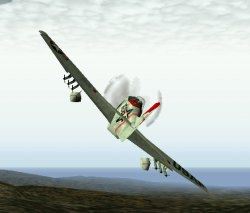
F51 Sound Like the late Spitfires and Hurricanes, the P51 used a variable pitch, constant speed propellor. This means that the propellor and engine speed can be controlled by the blade pitch and is relatively independent of the throttle setting. The constant speed propellor improves the efficiency and perfomance of the aircraft while reducing the wear on the engine. The sim models the action of the propellor and the change in pitch of the blades. This ensures that the engine speed varies very little as the throttle setting is changed. This explains why you don’t hear the characteristic pitch change when the throttle is moved. You should, however, hear a change in the volume of the engine noise. The default setting for the engine volume is low(Preferences), this can be wound up to get a bigger effect. Only two settings are provided for the desired engine speed(shift 0):
3000rpm for take-off, climbing and combat Shift 0 does give a variation in pitch but we accept that it is not a large as it could be. We have not found a better authentic sample that loops satisfactorily. Conclusion In conclusion, then, we know that MiG Alley can be improved but we think it is a good and enjoyable experience now. That is why I was happy to let it be mastered. All developers would like to keep on improving their game but we have to be aware of the commercial pressures. Development costs have risen by a factor of ten in just five years and publishers are withdrawing from the market. These are very worrying problems for us in the industry.
|
|||
|
Copyright © 1997 - 2000 COMBATSIM.COM, INC. All Rights Reserved. Last Updated July 22nd, 1999 |
||||
